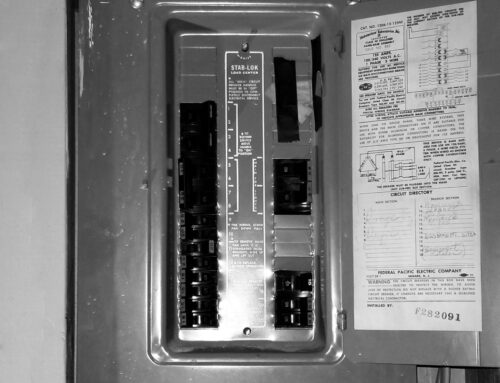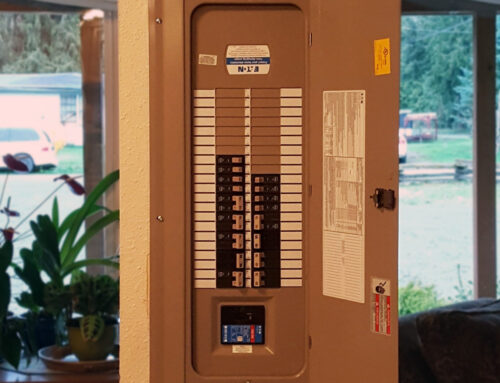Circuit breakers handle two important jobs for your electrical system:
- Delivering power to the various parts of our home (so that we can use it)
- Turning power OFF when there’s a problem (so that a fire doesn’t occur)
Breakers trip from having too many devices or appliances using power on the circuit at the same time. Older homes will often have the most problems, because they have the least amount of circuits and receptacles compared to new homes.
The breakers you’re likely to have inside your home are thermal-magnetic circuit breakers, which have bimetal switches and electromagnets used to trip a breaker. Breakers that have only one switch on their own are called single-pole breakers.
Breakers that have a handle between two switches are called two-pole or double-pole breakers. Two-pole circuit breakers are required on multi-wire branch circuits (MWBCs), where two different circuits share one neutral wire. This is common on all electric ranges, dryers, water heaters, and other various circuits around the home that share a neutral.
What kinds of specialty breakers are there?
Your home might have one of a number of specialty breakers, which provide other protections in addition to the standard thermal-magnetic overload protection.
GFCI Breakers
Ground-Fault Circuit Interrupter (GFCI) breakers have the same function as other GFCI devices in your home. GFCIs protect from electrical shocks, and may be used on circuits like bathroom and garage receptacle circuits.
The GFCI breaker will have a button on it to test it, similar to the test button on a GFCI receptacle. Pressing this TEST button will trip the breaker, and it will typically leave the handle in the “middle” position. The switch will NOT turn back on until turning it completely off first. Once flipped completely off, flip it back on to restore power as normal.
If pressing the button does not trip the GFCI breaker, the protection is no longer provided and must be replaced. Typically, a GFCI breaker costs about ten times the cost of its standard breaker counterpart.
AFCI Breakers
Arc-Fault Circuit Interrupter (AFCI) breakers are the newest protection required on new or altered circuits for many parts of your home. Like a GFCI breaker, it will have a button on it to test, and resets in a very similar manner.
Electric arcs, such as parallel arcs and series arcs, are a common cause of electrical fires. AFCI protection protects by recognizing arcing conditions and turning the circuit off before a fire occurs.
A parallel arc occurs when electricity intermittently jumps a gap between wires of different voltages, such as Line to Line (2 hot conductors of different phases), Line to Neutral, or Line to Ground.
For example, a parallel arc could be caused by a nail protruding through drywall, damaging the wire in the wall and exposing the hot and neutral wires. If the damaged wires are close enough together, an arc may occur between the exposed wires.
Because a parallel arc occurs between conductors at different voltages, the amount of current can vary widely, from very little to an extremely high amount (as much as the available short-circuit current for that circuit).
A series arc occurs when electricity intermittently jumps a gap between two or more points within the same phase.
For instance, if a wire is only loosely connected under the screw terminal of a wall switch, and there is a small enough gap between the wire and the terminal, an arc may occur between them. But because a series arc occurs within the same phase, the amount of current is no higher than the load current itself.
When AFCI protection was first introduced, the only breakers that provided protection were called Branch Circuit AFCI breakers; these breakers only provided parallel arc protection with no series arc protection. The newest AFCI breakers are Combination AFCI breakers, which provide both parallel and series arc protection.
AFCI breakers come in single- and double-pole breakers. Like a GFCI breaker, an AFCI breaker costs about ten times as much as its standard breaker counterpart.
Dual-Function Breakers
Dual-function breakers are a combination of AFCI and GFCI protection wrapped into one breaker. These breakers are often very practical to use for circuits requiring both different types of protection.
Instead of having a GFCI elsewhere on an AFCI circuit, one single breaker can have all the protection and testing in one spot. Areas where dual-function breakers are very useful are kitchen and dining receptacles, dishwasher, and disposal circuits. Currently, dual-function breakers only come in single-pole breakers, making it impossible to use them on existing MWBCs that require both protections, so additional work is required to provide GFCI and AFCI.
Like AFCI and GFCI breakers, they also cost about ten times more than a standard breaker.
Why does my breaker keep tripping?
It can be complicated to figure out why a circuit breaker trips repeatedly. Check out our blog post on Why Does My Circuit Breaker Keep Tripping?



